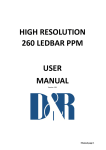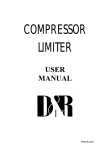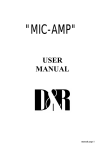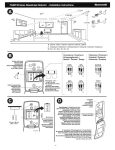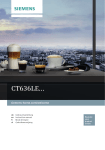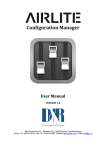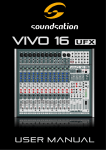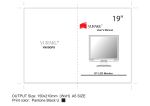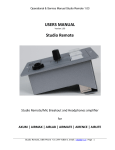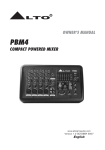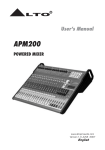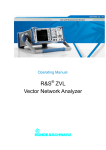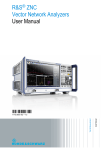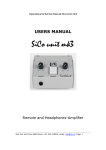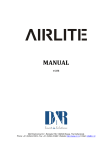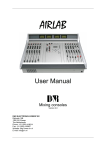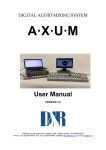Download USER MANUAL
Transcript
DE-ESSER USER MANUAL Manual page 1 Geachte klant, Wij danken u hartelijk voor uw keuze en het vertrouwen dat u in ons produkt stelt. U deed een goede keus, dit produkt is ontworpen door en voor professionele gebruikers. Er is gebruik gemaakt van onze enorme "know how" in mengtafel en signaal processor technieken en dit gekombineerd met hoogwaardige komponenten geeft u de zekerheid van een lange gebruiksduur. Bovenstaande eigenschappen resulteren in een zeer betrouwbaar en bedrijfszeker eindprodukt. Deze gebruiksaanwijzing helpt u in het optimaal benutten van alle mogelijkheden die dit produkt in zich heeft. Wij excuseren ons voor het feit dat deze gebruiksaanwijzing uitsluitend in het engels verkrijgbaar is. Dit is een gevolg van het feit dat 99% van onze produkten geexporteerd worden en het engels de algemeen aanvaarde internationale voertaal is. Mocht u nog vragen hebben dan kunt u zich altijd tot onze dealers wenden. Dear client, Thank you for choosing this product. This product is designed by specialists in the field of professional audio and is intended to be used as a professional tool. We are confident that you will be using this product for many years to come, and wish you much success. We always value suggestions from our clients, and we would therefore be grateful if you could complete and return the questionnaire included at the back of this manual, once you have become familiar with this product. We will certainly learn from your comments, and very much appreciate your time doing this. With kind regards, Duco de Rijk President D&R ELECTRONICA WEESP B.V. Rijnkade 15B 1382 GS WEESP-HOLLAND The Netherlands Phone: 0294-418 014 Fax: 0294-416 987 Website: http://www.d-r.nl E-mail: [email protected] Manual page 2 USER MANUAL D&R DE-ESSER Table of Contents 1. System description. 2. Voltage selection. 3. Installation. A. Input connections B. Output connections C. Stereo-link connections 4. System operation. A. "On" switch B. "Pass" switch C. "Tune" control D. "Monitor" switch E. "Threshold" control 5. General use of your D & R De-esser. 6. Technical specifications. Manual page 3 1. System description The D & R de-esser was designed to "deal-with" and in most cases eliminate high sibilance energy normally associated with the human voice. With the latest in technology available, the D & R Engineering staff has developed a product that solves the problem of high dynamics without risking overload. The heart of the de-esser is a new V.C.A. (Voltage Controlled Attenuator) which is arranged in a subtraction principle to achieve lower distortion. As you become more familiar with the switches and controls of your de-esser, you will soon realize that this fine piece of craftmanship will become one of the most valuable tools in your system. 2. Voltage selection Before plugging your D & R de-esser into the electrical supply, carefully check the position of the voltage selector on the rear of the unit. The voltage should be the same as your local electrical outlets. 3. Installation A-Input connections Balanced using a 1/4 inch stereo phone plug: tip = in phase (high) ring = out of phase (low) sleeve = shield (ground/earth) Unbalanced using a 1/4 inch mono phone plug: tip = in phase (high) sleeve = shield (ground/earth) Attention: If you use a 1/4 inch stereo phone plug in an unbalanced connection and experience a signal loss, the ring should be connected to ground or earth. B-Output connections Unbalanced using a 1/4 inch mono phone plug: tip = in phase (high) sleeve = shield (ground/earth) Manual page 4 C.Stereo-link connections Although the D & R de-esser is a single channel unit, you may connect two units to de-ess a stereo signal. To do this; plug a mono 1/4 inch jack cord into the link jacks and press "in" the link switches on the front panels of each unit. 4. System description A."On" switch This switch applies electricity to the internal power supply which activates the electronic circuitry. A green LED indicates the "on" mode. If this switch is off (out of position, green LED off) the signal will bypass the unit. B."Pass" switch The D & R de-esser has a band filter which can be switched between two bandwidths and determines the amount of limiting of the selected frequencies. The sharp filter limits the sibilances only. While the broad filter limits a wider range of frequencies and is easier to tune. For the sharp filter, the switch would be out and for the broad filter the switch would need to be pressed in. C."Tune" control This control determines the center frequency that will be limited. The center frequency is variable from lkHz to 15kHz. D."Monitor" switch This switch allows you to listen to the output of the filter section making it easy to select the correct frequency and the optimum bandwidth. A red LED lights when the monitor switch is activated. E."Threshold" control This control determines the level at which the limiting takes action. The LED array indicates the amount of limiting in dB's. 5. Using your D & R de-esser We recommend you patch the de-esser into a pre-fade patch point or insert on your console or patchbay, however, before patching this or any other signal processing equipment, adjust your levels (before and after) the insert/patch point correctly. This practice will allow an easy setup of any signal processing equipment. Remember, the de-esser should be connected in series with the signal) source. Now, activate the monitor switch and tune to the correct frequency while the "Pass" switch is in the broad position. Manual page 5 Turn the "threshold" control clockwise until you see the 11 dB LED flash on, or counter-clockwise if the LED array is higher than 11 dB. Adjust the "Tune" control until a maximum reading is achieved. By interacting betwee the "Threshold", "Tune" controls, and "Pass" switch, the optimum control of the signal can be achieved by the deesser's V.C.A. Now, release the "Monitor" switch and adjust the "Threshold" control for removing the desired amount of sibilants. You can now decide whether you would prefer to limit a wide band of frequencies or just the excessive sibilants by switching the "Pass" switch. 6. Technical specifications Frequency response Maximum in/out level Input Output Threshold Maximum limiting Filter range Attack Release Signal to noise Distortion (THD) 10Hz - 20kHz - 0.4dB 2Hz - 80kHz - 3.OdB +22dBu Balanced 47kOhm Unbalanced 100 kOhm -20dB - +20dB 30dB 1kHz - 15kHz Program dependent 2 ms - 220 ms program dependent -84dBu 0.04% with 25dB limiting 0.009% outside limit range D&R Electronica Weesp b.v. Rijnkade 15b 1382 GS WEESP THE NETHERLANDS Phone : 0031 2940 18014 Manual page 6 GEBRUIKSAANWIJZING DE - ESSER INHOUDSOPGAVE 1. De de-esser. 2. Netspanningscontrole. 3. Aansluiting. a. Ingang b. Uitgang c. Stereo - link 4. De werking en bediening van de de-esser. a. On-schakelaar b. Pass-schakelaar c. Tune-filter d. Monitor e. Threshold 5. De de-esser in de praktijk. 6. Technische gegevens. Manual page 7 1. De de-esser Het blijft moeilijk om geluiden zo hard mogelijk en met een zo groot mogelijk dynamisch bereik vast te leggen. Vooral opnames van de zang, met zijn onverwachte niveau's en zijn enorme energie in de hogere frequenties, zoals bij de "sis"-klanken, zijn problematisch. Natuurlijk worden er nog redelijke resultaten behaald met behulp van een compressor en equalizer. Deze oplossing is echter niet alleen duur, maar geeft ook niet de gewenste resultaten omdat hierbij ook andere essentiële klanken van de stem verloren gaan. De de-esser van D & R rekent absoluut af met alle hierboven genoemde problemen. 2. Netspanningscontrole Controleer alvorens het apparaat met het net te verbinden, of de rode netspanningsschakelaar 115/230 volt op de achterzijde van de de-esser in de stand staat, welke overeenkomt met de spanning van het plaatselijke net. Een variatie van plus en min 10% is toegestaan. 3. Aansluiting a.Ingang De ingang van de de-esser is zowel gebalanceerd als ongebalanceerd te gebruiken. Indien deze als gebalanceerde ingang wordt gebruikt, dan dient de "in fase" kant aan de tip en de "uit fase" kant aan de ring van de stereo jackplug te worden bevestigd. Bij ongebalanceerd gebruik, wordt de signaaldraad met de "tip" en de massa met de "ring" van de jackplug verbonden. Maak bij een ongebalanceerde aansluiting altijd gebruik van een mono jackplug voor een optimaal frequentiebereik van de de-esser. Let op! Indien u signaalverlies bemerkt, heeft u de ingang ongebalanceerd aangesloten via een stereoplug waarvan de ring niet aan aarde ligt. b. Uitgang De uitgang van de de-esser is ongebalanceerd. In dit geval wordt het signaal van de tip afgenomen en de ring van de stereo jackplug ligt aan massa. c.Stereo link De de-esser is een apparaat wat dienst doet voor een enkel kanaal. Voor bewerking van een stereo signaal kunnen twee de-essers door middel van de stereo link met elkaar worden verbonden. Indien op beide apparaten de schakelaar "stereo link" op het front wordt ingedrukt, reageren beide de-essers tegelijkertijd op het aangeboden signaal. Een groene indicatieled licht op na het indrukken van de "stereo link" schakelaar. Gebruik bij deze in/uitgang een snoer met aan beide zijden een mono jackplug. Manual page 8 4. De werking en bediening van de de-esser Het electronisch hart van de de-esser is een nieuw, uiterst stabiel type V.C.A. (spannings gestuurde versterker). Om deze V.C.A. heen zijn tal van electronische regelingen gebouwd, welke de werking en de bediening van de de-esser bepalen. a.On-schakelaar Met deze schakelaar wordt de de-esser aangezet. De groene indicatieled licht op. Indien de schakelaar "uit" gedrukt staat, laat de de-esser het signaal onveranderd door. Dit is de zogenaamde bypass. b.Pass schakelaar In de de-esser is een bandfilter ingebouwd. Dit filter is in te stellen op 2 verschillende bandbreedtes en bepaalt het frequentie-gebied, waarin moet worden begrenst. Het steile filter onderdrukt bijvoorbeeld alleen de echte "sis"klank. De rest van de stemfrequenties worden hierbij niet beinvloedt. Het minder steile filter is iets makkelijker in te stellen, maar onderdrukt wel meerdere omliggende frequenties. De keuze tussen deze twee filters kan worden gemaakt met de rode drukknop "select pass" op het front. c.Tune filter De draaiknop tune filter geeft aan waar gefilterd wordt. De frequenties zijn in te stellen tussen de 1 en 15kHz. d.Monitor De monitor schakelaar geeft de mogelijkheid om alleen het te onderdrukken signaal weer te geven. op deze manier is het eenvoudig een keuze te maken, welk soort bandfilter en op welke frequentie deze gebruikt moet worden. Bij een ingedrukte schakelaar gaat tevens de rode indicatie led branden. e.Threshold Met deze draaiknop wordt de niveaugrens bepaald waarboven onderdrukt moet worden. De ledbar, bestaande uit 5 led's, geeft de mate van begrenzing aan in dB's. 5. De de-esser in de praktijk. U sluit de de-esser aan in serie met een signaalbron en drukt de "on"-schakelaar in. Vanaf dat moment is de monitor schakelaar te gebruiken. U kunt nu precies het tune filter en de karakteristiek daarvan instellen. Dit gebeurt door middel van de threshold regeling rechtsom te draaien totdat u een uitlezing heeft op de ledbar. Vervolgens "zoekt" u met de tune-regelaar de hoogste amplitude op van het te limiten signaal. Geeft de ledbar een te hoge uitslag, dan eenvoudigweg de threshold-regelaar terugdraaien en verder "tunen". Op deze wijze kunt u met de threshold, tune en breed en smalband filterschakelaar de meest optimale uitsturing opzoeken. Manual page 9 6. Technische gegevens Frequentiebereik 10Hz - 20kHz -0f4dB 2Hz - 80kHz -3.0dB Maximaal ingangsniveau Maximaal uitgangsniveau +22dBu +22dBu Ingang Uitgang Threshold bereik Maximale limiting Filter frequentie Attack tijd Release tijd : Signaal/ruisverhouding Vervorming (THD) gebalanceerd 47kOhm ongebalanceerd 100 kOhm -20 dB tot + 20dB 30dB 1kHz - 15kHz Afhankelijk van instelling / automatisch 2 ms - 220 ms/automatisch -84dBu < 0,04% bij 25dB limiting. < 0,009% buiten limitgebied. Zodra u de werking van de D & R de-esser onder de knie heeft, zult u merken dat dit stuk randapparatuur met zijn vele mogelijkheden en zijn betrouwbare werking een onmisbaar stuk electronica wordt in uw studio. Wij wensen u er veel plezier mee. D & R Electronica b.v. Augustus 1989 Manual page 10 BELANGRIJKE VEILIGHEIDS- EN VOORZORGSMAATREGELEN LET OP: Lees de gebruiksaanwijzing aandachtig door alvorens het produkt in gebruik te nemen. Bewaar de gebruiksaanwijzing voor het geval u in de toekomst verdere informatie wenst betreffende de bediening van uw deesser. Opstelling en behandeling Open in geen geval de behuizing van het apparaat. Het aanraken van inwendige onderdelen kan een electrische schok of beschadiging van hget apparaat tot gevolg hebben. Laat onderhoud en eventuele afstelling binnenin het apparaat over aan een door D&R erkende dealer of service centrum. Stel uw D&R apparaat niet bloot aan direct zonlicht en zet het niet in de buurt van een warmtebron. Plaats geen voorwerp dat water of een andere vloeistof bevat op uw apparaat. Mocht er toch vloeistof in het inwendige van het apparaat terechtkomen, trek dan meteen de stekker uit het stopcontact en neem contact op met een erkende dealer. Indien uw apparaat defekt is, laat dan de reparatie over aan een erkende dealer. Laat uw apparaat niet vallen Manual page 11 DECLARATION OF CONFORMITY Manufacturers Name: D&R Electronica Weesp b.v. Manufacturers Address: Rijnkade 15B, 1382 GS Weesp, The Netherlands declares that the product DE-ESSER conforms to the following product specifications: EMC: EN 55022: 1987 CISPR 22 (1993) class B EN 500082-1 (1992) Supplementary Information: The products herewith complies with the requirements of the EMC Directive 89/336/EEC (1989) as amended by the CE Marking Directive 93/68/EEC (1993). D&R Electronica Weesp b.v. Rijnkade 15 B 1382 GS WEESP The Netherlands President of Engineering Manual page 12 PRODUCT SAFETY This product is manufactured with the highest standards and is double checked in our quality control department for reliability in the "HIGH VOLTAGE" section. CAUTION Never remove any panels, or open this equipment. No user servicable parts inside. Equipment power supply must be grounded at all times. Only use this product as described, in user manual or brochure. Do not operate this equipment in high humidity or expose it to water or other liquids. Check the AC power supply cable to assure secure contact. Have your equipment checked yearly by a qualified dealer service center. Hazardous electrical shock can be avoided by carefully following the above rules. EXTRA CAUTION FOR LIVE SOUND Ground all equipment using the ground pin in the AC power supply cable. Never remove this pin. Ground loops should be eliminated only by use of isolation transformers for all inputs and outputs. Replace any blown fuse with the same type and rating only after equipment has been disconnected from AC power. If problem persists, return equipment to qualified service technician PLEASE READ THE FOLLOWING INFORMATION Especially in sound equipment on stage the following information is essential to know. An electrical shock is caused by voltage and current, actually it is the current that causes the shock. In practise the higher the voltage the higher the current will be and the higher the shock. But there is another thing to consider and it is resistance. When the resistance in Ohms is high between two poles, the current will be low and vica versa. All three of these; voltage, current. and resistance are important in determining the effect of an electrical shock. However, the severity of a shock primarily determined by the amount of current flowing through a person. A person can feel a shock because the muscles in a body respond to electrical current and because the heart is a muscle it can affect, when the current is high enough. Current can also be fatal when it causes the chest muscles to contract and stop breathing. At what potential is current dangereous. Well the first feeling of current is a tingle at 0.001 Amp of current. The current between 0.1 Amp and 0.2 Amp is fatal. Imagine that your home fuses of 20 Amp can handle 200 times more current than is necessary to kill. How does resistance affect the shock a person feels. A typical resistance between one hand to the other in "dry" condition could well over 100,000 Ohm. If you are playing on stage your body is perspiring extensively and your body resistance is lowered by more than 50%. This is a situation in which current can easily flow. Current will flow when there is a difference in ground potential between equipment on stage and in the P.A. system. Please do check if there is any potential between the housing of the mikes and the guitarsynth amps, which will be linked by your body on stage. Imagine, a guitar in your hand and your lips close to the mike! A ground potential difference of above 10 volts is not unusual, in improperly wired buildings it can possibly be as high as 240 volts. Manual page 13 Allthough removing the ground wire sometimes cures a system hum, it will create a very hazardeous situation for the performing musician. Always earth all your equipment by the grounding pin in your mains plug. Hum loops should be only cured by proper wiring and isolation input/output transformers. Replace fuses always with the same type and rating after the equipment has been turned off and unplugged. If the fuse blows again you have an equipment failure, do not use it again and return it to your dealer for repair. And last but not least be carefull not to touch a person being shocked as you, yourself could also be shocked. Once removed from the shock, have someone send for medical help inmediately Always keep the above mentioned information in mind when using electrically powered equipment. Manual page 14 Dear CLIENT, We care very much about your opinion of our product, and would very much appreciate if you could complete the following questionnaire, and return it to the address below. Please use a copy of this form if you do not want to damage your manual. USER NAME .............................................................................................................................................................. ORGANIZATION ....................................................................................................................................................... ADDRESS ................................................................................................................................................................... TOWN ......................................................................................................................................................................... POST CODE .............................................................................................................................................................. COUNTRY ................................................................................................................................................................. EMAIL: [email protected]...................................................................................................................................................... PURCHASING DATE: .............................................................................................................................................. CONFIGURATION .................................................................................................................................................... DEALER ..................................................................................................................................................................... HOW DID YOU HEAR ABOUT THIS PRODUCT? (please circle) (Dealer / Advertisement / Exhibition / Other user / Other) WHAT JOURNALS DO YOU TAKE ON A REGULAR BASIS? ..................................................................................................................................................................................... WHAT IS YOUR OPINION OF THE PRICE/QUALITY OF THE 'AIRLAB'? ..................................................................................................................................................................................... WHAT PRICE WOULD YOU CONSIDER SUITABLE FOR THE 'AIRLAB'? ..................................................................................................................................................................................... ANY OTHER SUGGESTIONS? ...................................................................................................................................................................................... I REQUIRE INFORMATION ABOUT ...................................................................................................................................................................................... WHAT OTHER EQUIPMENT DO YOU USE? ..................................................................................................................................................................................... PLEASE SEND/FAX TO: D&R Electronica Weesp bv, Rijnkade 15B, 1382 GS WEESP, The Netherlands FAX: +31 294 416987 Manual page 15 DE-ESSER SERVICE MANUAL Manual page 16 Manual page 17


















